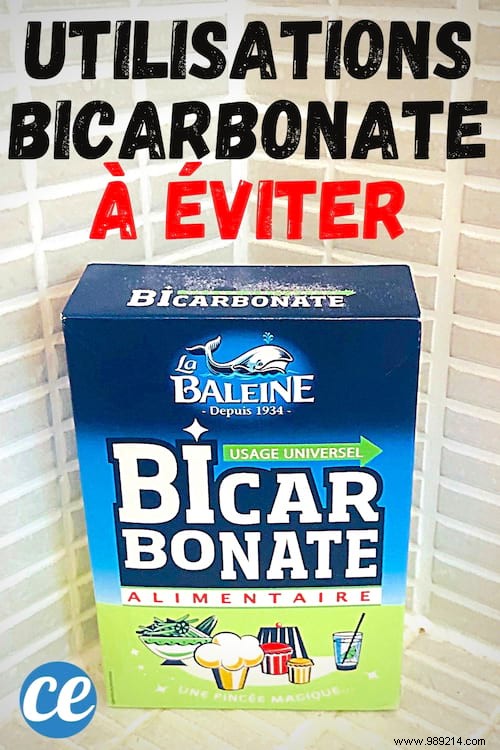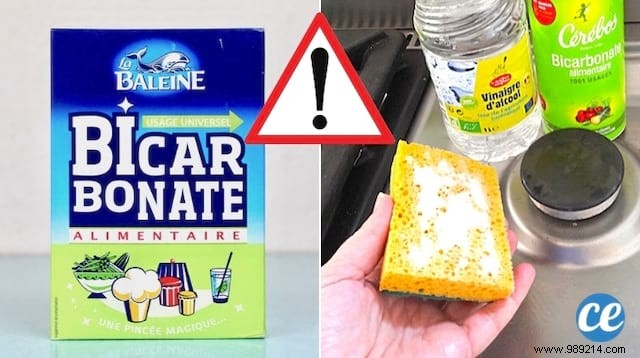
You know baking soda of course.
It's a natural cleansing product so effective that you want to use it for everything.
And it's true that it can be used for many things...
But that doesn't mean you can use it for everything!
Indeed, there are some rare occasions where food or technical bicarbonate is not recommended.
What things should not be cleaned with baking soda?
Here are 9 uses where baking soda can be a hazard to the material being cleaned. Watch:

Many metal surfaces can be cleaned with baking soda.
But be careful if you clean aluminum cookware with baking soda.
If you use it quickly and rinse it quickly, then no problem.
But if you leave it on the aluminum surface for too long, it can oxidize the surface.
The surface of your kitchen utensil may then change color.
Nothing really bad, but it's still a precaution to take.
To discover: 7 Easy Tips For Cleaning All Types Of Pots And Pans.
You may have already noticed this.
If your silverware is tarnished, baking soda can quickly restore its shine.
But some specialists advise against cleaning old silverware with baking soda.
According to them, the small grains of the bicarbonate could be too abrasive.
They could mar the finish, especially if you are unsure of the quality of the silverware.
And don't use it on pieces of your service that feature stone decorations like turquoise or pearls.
If it is a really precious object, it is better to entrust it to a professional.
To discover: The Only Miracle Product To Clean Silverware Easily.
Well... We have to admit.
It is unlikely that some parts of your service will be 24k gold plated.
If it has the same color as gold, it is definitely an alloy of gold or brass.
However, if you have a porcelain service, it may have a real gold border.
In that case, be careful with the baking soda.
Gold is a soft metal that scratches easily.
Even with a mild abrasive like baking soda.
To discover: 5 Magic Tricks To Clean Gold Jewelry.
Regularly, we recommend that you clean the marble with baking soda.
That said, professionals have reservations.
They believe that repeated applications can end up damaging the surface.
They therefore recommend using the cleaning products provided for this purpose.
But it is unlikely that light and exceptional use will really damage marble...
It is enough to dilute the bicarbonate well and not to rub too hard to avoid any risk.
To discover: Here's How To Clean And Shine MARBLE Easily.

As baking soda is an abrasive cleaner, avoid using it pure on glass surfaces.
It is better to use it diluted or on a damp sponge to avoid any risk of micro scratches on delicate objects.
But in some cases, using baking soda on a window can be very useful.
This is particularly the case for cleaning traces of limestone encrusted on the windows of the shower.
To discover: The Trick Of A Window Cleaner To Have Nickel Windows Without Any Trace.
Bicarbonate is a light abrasive that gently strips.
Handy for stripping wood naturally...
...or remove a stubborn stain from wooden furniture.
But using baking soda on wooden furniture can have another consequence.
The baking soda will slightly scratch the surface of the wood.
The consequence is that it can damage the coating of the wood, especially the varnish.
It should therefore be used with caution on wood, without rubbing too hard.
To discover: The Economical Tip to Clean Wooden Furniture Naturally.
Bicarbonate is a very effective product for cleaning cooking plates.
Especially when there are grease deposits or burnt and encrusted residues.
Because the bicarbonate will take off the dirt and eliminate it, thanks to its abrasive action.
But be careful not to rub too hard.
Because even if it is a soft abrasive, we are not immune to micro scratches.
And if you use it alone on a ceramic hob, it may leave a white film.
In that case, don't panic! A shot of spray with white vinegar will remove it quickly.
To discover: How to Clean a Ceramic Hob with White Vinegar.
Bicarbonate is often recommended to fight acne.
And for good reason ! Baking soda purifies the skin and dries out pimples.
Combined with other natural products, it turns into a real natural treatment for problem skin.
But remember that used alone, baking soda can have a drying effect on the skin.
It can cause redness and burning in people with sensitive skin.
If your skin is sensitive, it is best to avoid using baking soda alone.
In this case, mix it with coconut oil, as explained here.
In any case, use a moisturizer after your bicarbonate treatment.
To discover :8 Incredible Benefits Of Hazelnut Oil For Your Skin.
You are often advised to use baking soda to take care of your hair.
But beware ! Because baking soda has a very alkaline pH of 9.
And hair has a pH between 4.5 and 5.
As a result, the hair can be attacked by baking soda.
Overuse of baking soda can cause them to become dry, dull and brittle.
How to avoid this problem? It's simple.
Always use it with an acidic solution (like vinegar) to preserve the hair's balance, as explained here.
And don't use it too often.
To discover: The Coconut Oil Mask Your Tired Hair Will LOVE.
You certainly know that. If you mix baking soda and vinegar, it sparkles very strongly!
Contact between the two products releases a gas.
If you mix them in a closed container, it can create an explosion which could injure you.
So avoid storing a mixture of baking soda and white vinegar. Mix it up and use it right away.
To discover: 3 Things to Know Before Mixing Baking Soda With White Vinegar.

Bicarbonate is made up of small fine grains. It is therefore an abrasive product.
This means that you have to be careful with certain surfaces.
The same way you would be careful not to scrub too hard with a scouring pad.
And since some metals are reactive, they can also discolor on contact with bicarbonate.
Of course, that doesn't destroy it. But it's not very pretty either.